Business growth is sweet, and like you, everyone craves it.
But growth, no matter how small, comes with its challenges:
- Too many clients to serve.
- Too many employees to manage at the same time.
- Difficulty maintaining consistency across how your company gets things done.
- Difficulties establishing streamlined processes.
- And other hectic, repetitive tasks.
As a business owner or manager, do you face any or all of these challenges?
You’re not alone.
Mario Alfaro, Manager at Soluciones Eficaces, also did until he used our product Tallyfy, to:
Create blueprints, and implement standard operating procedures (SOPs) in his growing business operations.
The result of doing this, you ask?
Mario was kind enough to share this:
“The considerable time savings to our service delivery time has had a direct impact on every employee’s performance and the number of clients we can serve.”
With SOPs, you can achieve this same ease of managing your business processes without sacrificing growth.
And as Mario and his team did , you can do it without juggling CRMs, note-taking apps, Google Calendar, and countless project management tools .
How?
By creating templates and writing simple, yet very powerful standard operating procedures.
Sounds interesting to you?
Read on, and you’ll see how to do it with Tallyfy in three (3) simple steps:

But first…
What are Standard Operating Procedures (SOPs)?
SOPs are brief, easy-to-understand and use documents, showing action points and workflows.
Ultimately, they create process flowcharts for performing defined tasks.
A great one outlines steps (so you don’t have to announce them over and again) for routine, business-growing actions like:
- Onboarding new customers
- Serving clients and delivering projects on time
- Training/onboarding new employees, and most importantly
- Managing employees and assigning tasks to both clients and employees.
- And others, as you need.
The highlights above are some processes you can carry out more easily by writing standard operating procedures for your business.
And I’ll tell you the truth.
Most reputable organizations you admire standardize their operations to achieve stability and growth without too many back and forth, using SOPs.
Take this article you’re reading, for example.
It didn’t get on Google’s 1st page by chance.
My team followed a 9-step standard operating procedure for content production, which adheres to Google’s ranking factors.
And by creating it as a template on Tallyfy, employees always know, and must follow outlined steps to producing high-quality content every time:
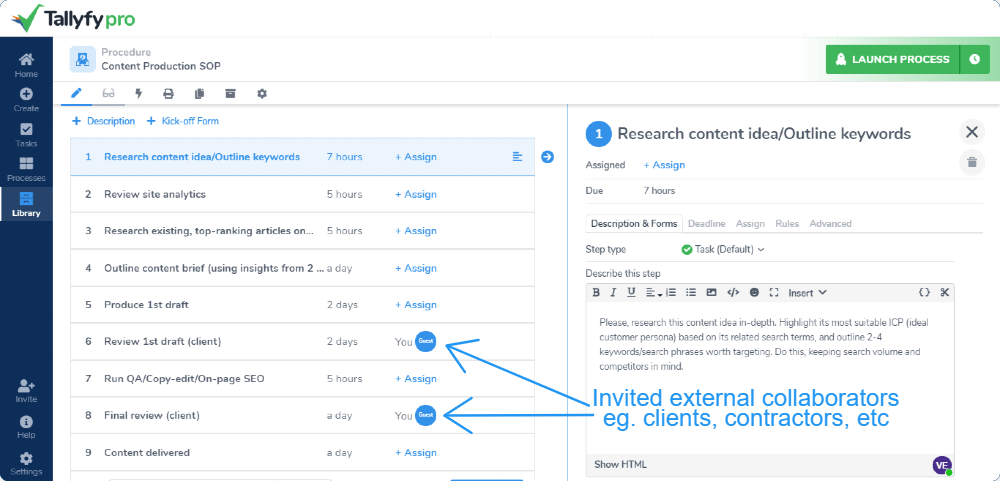
As you see in the screenshot above, managers save the back and forth, reminding other employees on how to produce top-notch content.
Also, they can invite external collaborators like contractors (and clients) to specific steps of the process, as needed.
That’s one example of what you can do with SOPs.
And the fact that you found this article (and still reading it) because Google ranks it shows that it’s wise to operate with SOPs.
The good thing?
Irrespective of your business type or associated tasks, you can write SOPs to facilitate how to manage different routine, yet important processes.
And as I showed you earlier, with Tallyfy, you can do it in three (3) simple steps:
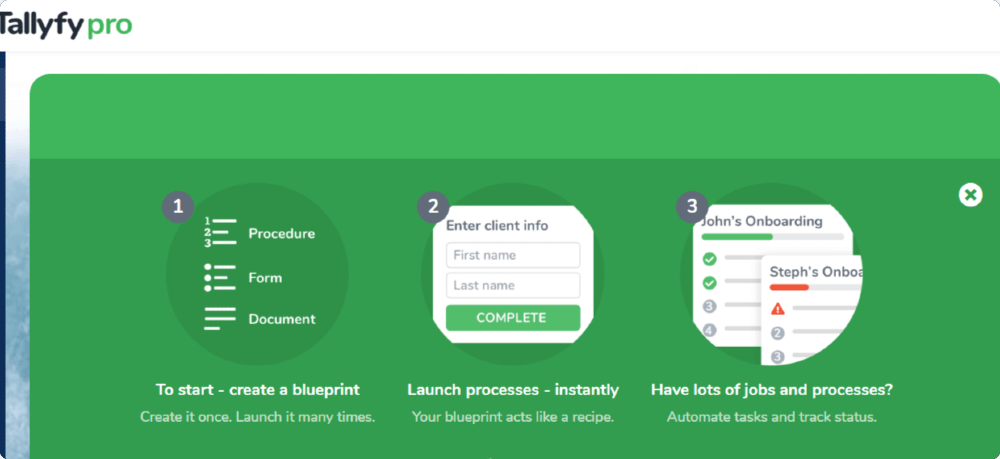
Three (3) Easy Steps to Write SOPs for Your Business
There’s no one-size-fits-all process for writing SOPs.
Due to this, most platforms make the process difficult, defeating the goal of creating one in the first place.
But with Tallyfy, you get a simplified, three (3) step process for writing standard operating procedures for your company.
What’s more?
As your company grows or the need to make changes arise, you can update your SOPs on Tallyfy and get the information across your organization without hassles.
Our three steps for writing SOPs are:
- Create a template of your company’s most-repetitive tasks
- Outline and launch each step on the template
- Assign and automate routine tasks with the required level of detail.
1. Create a template for repetitive tasks
As your business grows, what duties do you perform every day or week?
It could be any of the ones outlined above — onboarding new customers, writing/publishing/updating content on your blog, managing projects between clients and employees, etc.
Now, have you ever thought of why you struggle to improve how you perform these tasks despite repeating them over and again?
Most times, it’s because you only have the process of doing them buried in your head.
Due to this, you do or tell employees one thing when you’re in a good mood, and another thing when you’re not.
The result?
It creates a lack of streamlined procedures for getting work done. In turn, you and employees do one thing today and another tomorrow.
You can’t scale your business like that, you know why?
It’s difficult to hold people accountable, improve how to do to work, or grow your business, using head-buried procedures that fluctuate with mood swings.
And that’s where the need to create templates, as you embark on writing SOPs come in.
See templates as a way of standardizing how you’ll perform routine tasks, going forward.
Ready to see how it’s done?
a. Develop a list of your business processes
Talk to your managers, who, in turn, should talk to other employees about duties performed in their jobs almost the same way daily, weekly, or monthly.
Your goal?
Review the list you and your team come up with. Then, highlight redundant jobs not performed with best practices due to a lack of standardized procedures.
These are the jobs for which you need to write standard operating procedures.
Don’t know where to start?
In Tallyfy, you’ll find a library of template samples for the most prominent, repetitive tasks our customers perform:
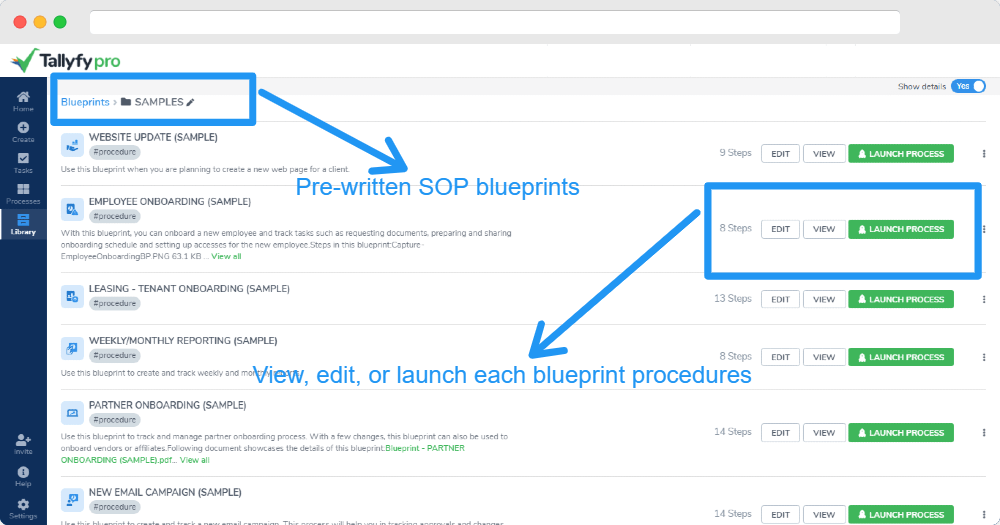
Editing, inviting collaborators, and launching SOP templates in Tallyfy takes only a few clicks. See how it works here.
b. Plan the Process
After you’ve made a list of redundant jobs you need templates for writing standard operating procedures for, the next step is to plan the process.
Let’s say your company launches new email campaigns every week.
To plan and write a standardized process of sending these campaigns in the future, get your team to outline all the steps they take to deliver this job.
Then, query yourself (and team): What format works best for executing the tasks in each job delivery template we’ll create? Is a step-by-step guide or workflow diagram better?
With Tallyfy, however, you won’t have to worry about that. We let you document SOP’s without flowcharts or workflow diagrams.
Just create a new template to standardize how you send email campaigns. Or, edit and add new steps in our pre-installed email campaign template:
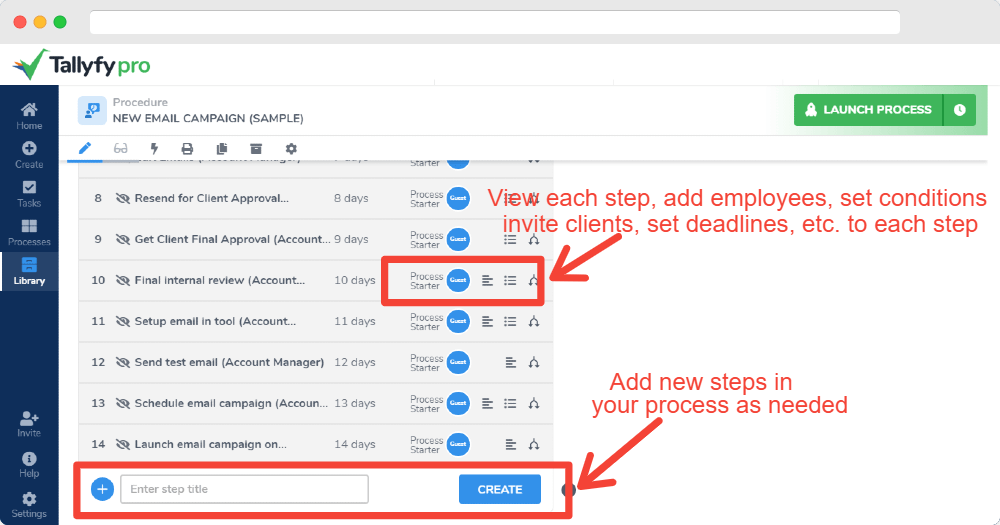
Once you’re done with the steps, Tallyfy automatically transforms it into an executable process – showing how the job proceeds to the finish line.
2. Outline and launch processes
c. Communicate with all employees
Who performs specific tasks in each process?
Depending on the size of your organization, creating an SOP template and outlining all the steps for completing it won’t do.
You need to communicate with everyone, and not just managers, who’ll be working on any step or specific task of this process.
That’s how you keep everyone on the same page and in sync with your standardized procedures.
Again, it’s easy to do this with Tallyfy.
Add a team member or invite a contractor to any task and communicate directly with them by leaving instructions or comments, which they can reply to:
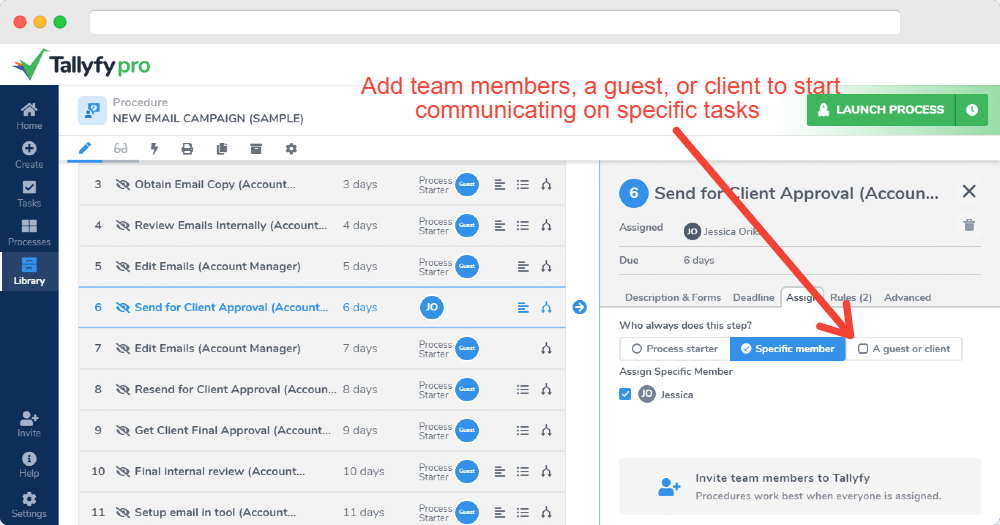
d. Write and review the entire process
This stage is when you add finishing touches to each SOP writing process.
Having communicated with employees, or made it easy for them to communicate with you on specific tasks, take a step back to review your standard operating procedure again.
It makes sense to get a final buy-in from managers and key employees too.
Essential things to be on the same page on is who is responsible for maintaining and ensuring that each written SOP is followed to the letter.
Doing this helps to ensure all SOPs across your organization reads the same way, but only describes specific jobs in a distinctive manner.
3. Assign and automate routine tasks
e. Maintain the process
Maintaining your standard operating procedures is as important as writing them.
Hence, your job doesn’t end the moment you’ve written and launched an SOP.
Does it make sense to continue doing the same work in the same way as you gain more hands-on experience?
No, right?
In the same vein, you must update your SOPs as the need arises. A common practice is to update them at least once per year.
Doing this and adding new notes to each SOP reminds employees on how to perform tasks better. It also reminds them of why they must adhere to laid down procedures.
In Tallyfy, you can assign a manager to each SOP to make this necessary updates, set due date for them to do so, and they’ll get a personalized dashboard where they’re always reminded of it:
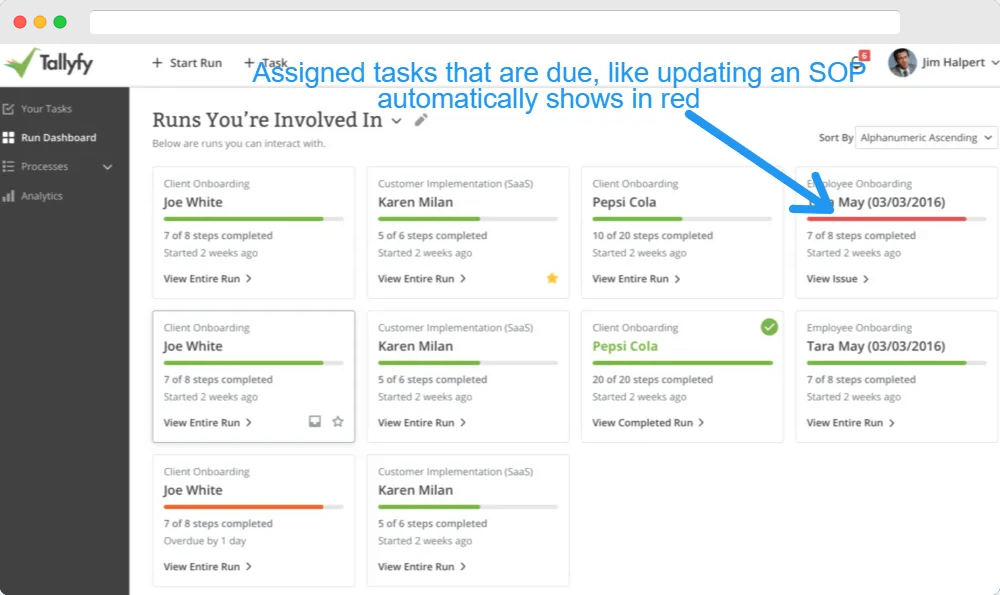
Start writing your SOPs and assigning tasks with Tallyfy. You can get started for free here.
If you’ve followed the steps up to this point, you’ll agree with me that standard operating procedures take time and some hard thinking to create.
But you know the fun part?
In the long run, they’ll save you a lot more time and frustration down the road.
Still not sold?
Well, let’s look at why you need SOPs and some benefits that come with them.
Why Do You Need Standard Operating Procedures, SOPs?
Most importantly, you need standard operating procedures because they take the guesswork out of how your company performs essential, repetitive tasks.
They also help to facilitate quality assurance and quality control for:
- Process management
- Process evaluation, and
- Your routine jobs’ process improvement.
For example, let’s say your company has a return policy.
It makes sense to have defined rules guiding employees on criteria to be met before you accept returned goods or issue refunds, right?
Good.
That’s an excellent case of why you need standard operating procedures.
With one, you don’t need to remind employees every time on what to look out for before they perform a task.
Employees, in turn, won’t bother you with unnecessary questions on tasks you’ve written SOPs for, saving everyone time for other tasks.
And that’s not all.
Other benefits of SOPs are as follows.
Standard operating procedures help you to hold employees accountable
How can you evaluate employees if you don’t have written standards in place?
The good thing is that standard operating procedures help to do more than just evaluating employees.
They help you to hold them accountable.
With laid down procedures for doing work outlined in your SOPs, you get a bird-view look on who did what (evaluation) and who didn’t (accountability).
SOP’s improve communication
When you write SOPs with clear instructions for performing specific tasks in the process, you improve communication with employees.
No longer would they need to rack their brains to remember how you told them to do things.
Instead, they can dash into descriptions attached to tasks assigned to them to refresh their memory, as well as communicate directly with you if there’s need for changes:
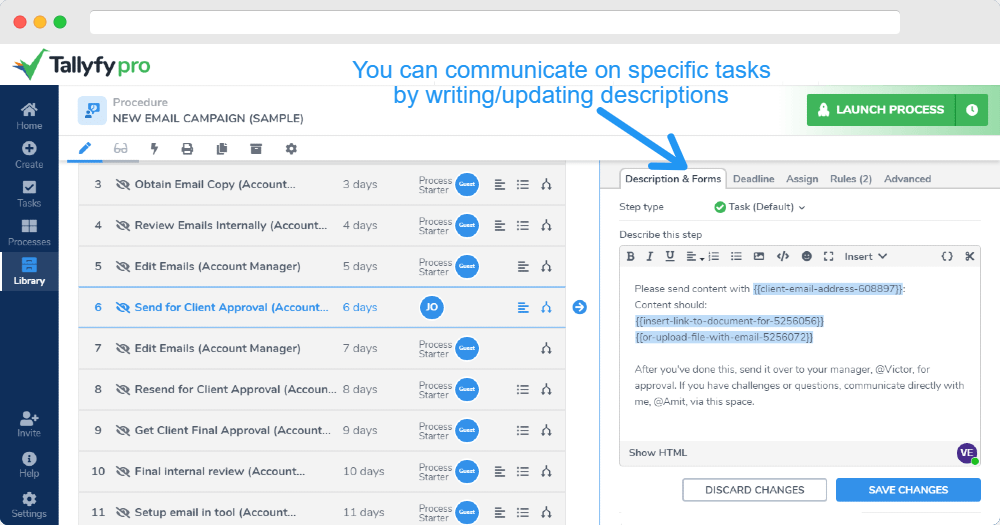
Back and forth communication with employees on tasks & processes is a breeze in Tallyfy.
Standard operating procedures create a safer work environment
When employees or contractors perform the same tasks in completely different ways, according to how they feel, it creates inefficiencies and causes a liability for your business.
Standard operating procedures empower employees to perform their job functions safely and consistently by adhering to safety rules attached to every task.
SOP’s provide consistency
With a standard operating procedure in place for working on specific tasks, you’ll rest assured, knowing business processes would follow outlined steps to completion.
The result of this is a consistent way of doing things across your organization, irrespective of how people feel.
For example, once you’ve created an email campaign template and written an SOP for it, you can maintain consistency by duplicating it for a new client, only making a few adjustments as needed:
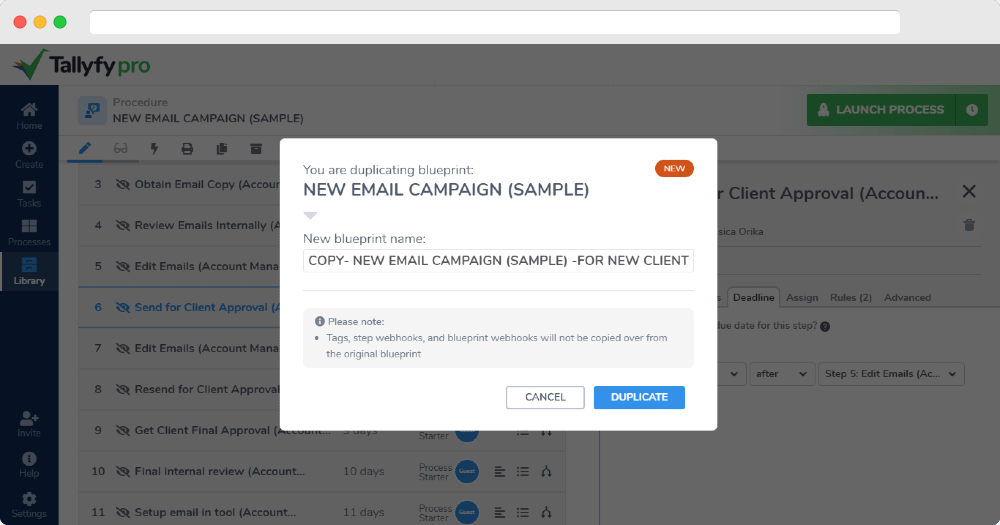
Tallyfy helps to maintain consistency by duplicating (and adding few adjustments to) templates, processes, or an entire SOP.
Conclusion: Writing SOPs Creates Flexibility in Your Business
A big misconception is that SOPs cause businesses to become inflexible and rigid.
Well, this report by the Harvard Business Review proves it wrong.
As per the report, writing standard operating procedures for your company makes business processes more efficient and flexible.
How, you ask?
In the report above, HBR profiled how The Cleveland Clinic uses SOP’s:
“To deliver operational consistency, reliability, and low cost. Yet at the same time, they use these standards as a springboard for creating unique solutions for each customer based on a deep understanding of their needs.”
And for us here at Tallyfy, this comes with no surprises.
Our customer success stories are full of business-growing results achieved by writing and maintaining standard operating procedures for performing business tasks in one place.
For example – Macklin Andrick, Operations Manager at Greetabl, said:
“With Tallyfy, we’ve seen clarity in our processes … as well as any bottlenecks.”
“Tallyfy would be a good fit for any company that has a design, approval and implementation process that needs to have a quick turn around, and that is growing fast.”
So, is your business growing?
Then, start writing SOPs to streamline your processes and perform repetitive tasks more smoothly.
With Tallyfy, not only can you do this, but you can:
- Duplicate and add a few adjustments to your written SOPs to maintain consistency.
- Update your SOPs without hassles, as the need arises.
- Assign tasks and communicate with employees from a single dashboard:
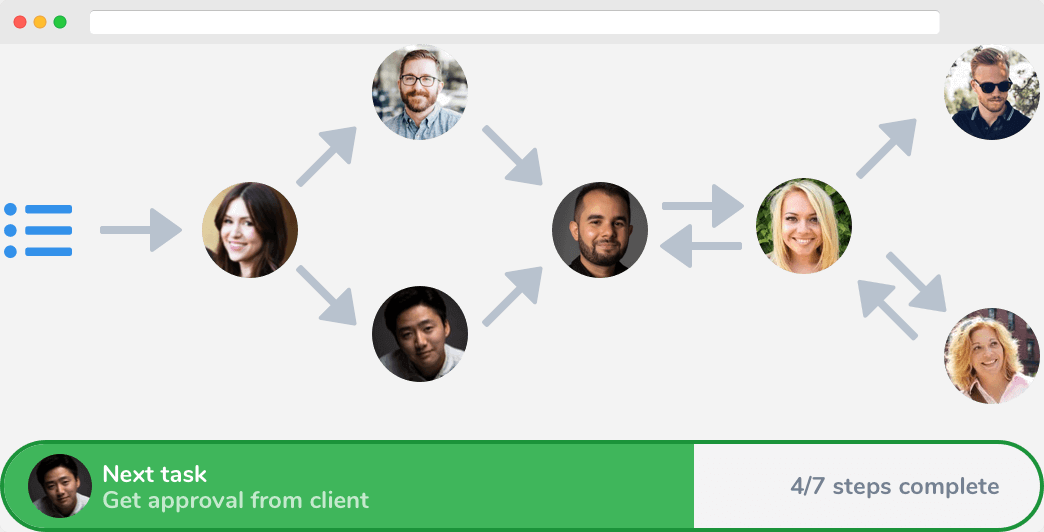
Start writing your SOPs and assigning tasks with Tallyfy. You can get started for free here.
Working at a large organization? You can book a demo here.
Stop bleeding 2 hours per person, daily - on busywork
Related Questions
What are the 5 essential parts of an SOP?
There is evidence that five components are commonly amongst those features of a well-written story are clear title and purpose statement, competently described step-by-step instructions, scope of use, roles and responsibilities, and a revision history. Think of it as a recipe: It has all ingredients, clear steps, who’s cooking and when it was last updated to ensure everything runs smoothly.
What is the main purpose of an SOP?
An SOP’s main objective is to bring consistency and high quality in the performance of a function. It’s like having a reliable map that takes everyone to the same place, minimizes mistakes and helps new team members hit the ground running. SOPs are the best way to do something, and ensure everybody does everything the same way.
What is an SOP and can you give an example?
An SOP is a written document that shows how to perform a routine activity. For instance, a coffee shop might have an SOP for preparing a latte, specifying: Grind the beans Pull an espresso shot Steam the milk to 150°F Pour the milk into the cup to allow for latte art Serve within 30 seconds. This way, every customer receives the same delicious latte, regardless of who makes it.
What are the different types of standard operating procedures?
SOPs are available in a variety of formats in order to accommodate differing requirements. Whereas step-by-step SOPs are like pure checklists, and hierarchical SOPs break tasks into sub-tasks, and flowchart SOPs visualize decision points, multimedia SOPs use photos or videos. Each kind does best for different situations, just as you might for driving compared to hiking.
How do you write an effective Standard Operating Procedure?
The first step to writing a good SOP is understanding your audience and the job very well. ‘Keep the language simple, use active voice, include images and pictures that are meaningful and make sure to test the instructions on real users.’ Dance learning is a bit like teaching someone how to ride a bike: You need steps, pictures could be useful, and you need to see someone trying your directions to verify that they make sense.
What’s the difference between an SOP and a process document?
Although either may serve as a guide, an SOP is generally more detailed, and more specific, than a process document. A process document is this big-picture view – it’s like a map to see your entire road trip of content. An SOP can zoom in on particular tasks — detailed directions, say, for getting through a tricky intersection. Process documents tells you what has to happen, SOPs tell you how to do it.
What are the key benefits of implementing SOPs?
SOPs have multiple benefits: they prevent mistakes, facilitate quicker training, guarantee adherence to standards, ensure quality and retain expertise when employees depart. They are almost like having an expert looking over everyone’s shoulders, ensuring they do things the right way, each and every time.
How often should SOPs be updated?
SOPs must be revisited and revised, at a minimum, once each year, or as significant changes to procedures, machinery or regulations are made. It’s the smartphone app analogy taken literally: They require regular updates to remain up to date and useful. Periodic reviews allow to catch up with obsolete information and add new advances.
What makes an SOP fail?
Standard operating procedures tend to go to the wayside when they are too complex, badly written, outdated, or not actually employed by employees. It’s as though you have a GPS that is confusing or inaccurate: If it’s too hard to follow or wrong, people will ignore it and forge their own path, negating the point of the GPS in the first place.
How do you implement SOPs successfully?
For the SOP to be successfully implemented a business needs to have clear communication, training, easy access to the right documents, and user feedback. The people who will use the SOPs should be involved in creating them. Think of it like introducing a brand-new game — everyone should have the rules, practice at the game, and have an opportunity to contribute to improving it.
What’s the role of SOPs in quality control?
SOPs are the key to quality control by establishing a standard and confirming compliance. It’s essentially the same reason chefs use recipes in restaurants, so that every dish meets the same high standards without regarding who’s cooking or when the food is made.

